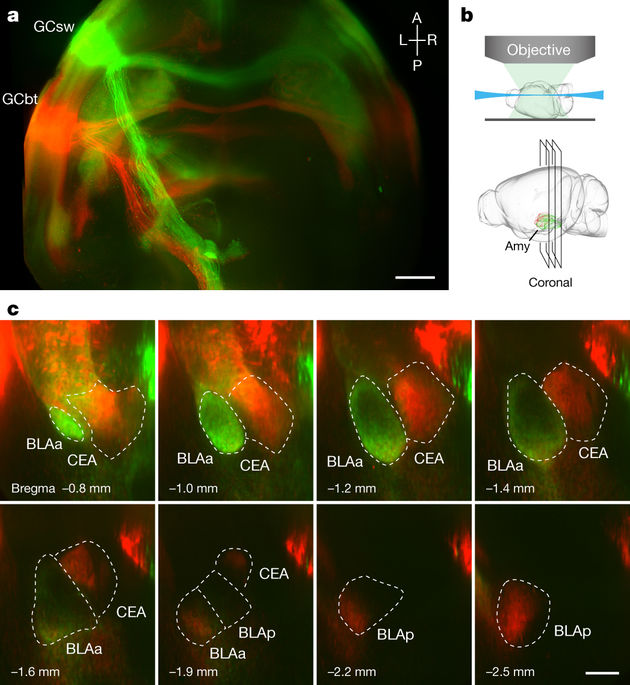Our official English website, www.x-mol.net, welcomes your
feedback! (Note: you will need to create a separate account there.)
The coding of valence and identity in the mammalian taste system
Nature ( IF 50.5 ) Pub Date : 2018-05-30 , DOI: 10.1038/s41586-018-0165-4 Li Wang 1, 2, 3 , Sarah Gillis-Smith 1, 2, 3 , Yueqing Peng 1, 2, 3 , Juen Zhang 1, 2, 3 , Xiaoke Chen 1, 2, 4 , C Daniel Salzman 3, 5 , Nicholas J P Ryba 6 , Charles S Zuker 1, 2, 3
Nature ( IF 50.5 ) Pub Date : 2018-05-30 , DOI: 10.1038/s41586-018-0165-4 Li Wang 1, 2, 3 , Sarah Gillis-Smith 1, 2, 3 , Yueqing Peng 1, 2, 3 , Juen Zhang 1, 2, 3 , Xiaoke Chen 1, 2, 4 , C Daniel Salzman 3, 5 , Nicholas J P Ryba 6 , Charles S Zuker 1, 2, 3
Affiliation

|
The ability of the taste system to identify a tastant (what it tastes like) enables animals to recognize and discriminate between the different basic taste qualities1,2. The valence of a tastant (whether it is appetitive or aversive) specifies its hedonic value and elicits the execution of selective behaviours. Here we examine how sweet and bitter are afforded valence versus identity in mice. We show that neurons in the sweet-responsive and bitter-responsive cortex project to topographically distinct areas of the amygdala, with strong segregation of neural projections conveying appetitive versus aversive taste signals. By manipulating selective taste inputs to the amygdala, we show that it is possible to impose positive or negative valence on a neutral water stimulus, and even to reverse the hedonic value of a sweet or bitter tastant. Remarkably, mice with silenced neurons in the amygdala no longer exhibit behaviour that reflects the valence associated with direct stimulation of the taste cortex, or with delivery of sweet and bitter chemicals. Nonetheless, these mice can still identify and discriminate between tastants, just as wild-type controls do. These results help to explain how the taste system generates stereotypic and predetermined attractive and aversive taste behaviours, and support the existence of distinct neural substrates for the discrimination of taste identity and the assignment of valence.The identity and hedonic value of tastes are encoded in distinct neural substrates; in mice, the amygdala is necessary and sufficient to drive valence-specific behaviours in response to bitter or sweet taste stimuli, and the cortex can independently represent taste identity.
中文翻译:

哺乳动物味觉系统中价和身份的编码
味觉系统识别味道(味道像什么)的能力使动物能够识别和区分不同的基本味觉品质1,2。味觉的效价(无论是食欲的还是厌恶的)指定了它的享乐价值并引发了选择性行为的执行。在这里,我们研究了在小鼠中甜味和苦味是如何被赋予效价与同一性的。我们表明,甜味反应和苦味反应皮层中的神经元投射到杏仁核的不同地形区域,神经投射的强烈分离传达了食欲与厌恶的味觉信号。通过操纵杏仁核的选择性味觉输入,我们表明可以对中性水刺激施加正价或负价,甚至可以逆转甜味或苦味味觉的享乐价值。值得注意的是,杏仁核中具有沉默神经元的小鼠不再表现出反映与直接刺激味觉皮层或传递甜味和苦味化学物质相关的效价的行为。尽管如此,这些小鼠仍然可以识别和区分促味剂,就像野生型对照一样。这些结果有助于解释味觉系统如何产生刻板的和预定的吸引和厌恶的味觉行为,并支持存在用于区分味觉同一性和分配价的不同神经基质。味觉的同一性和享乐价值以不同的方式编码神经基质;在小鼠中,杏仁核对于驱动对苦味或甜味刺激的价特异性行为是必要且足够的,而皮质可以独立地代表味觉特征。
更新日期:2018-05-30
中文翻译:

哺乳动物味觉系统中价和身份的编码
味觉系统识别味道(味道像什么)的能力使动物能够识别和区分不同的基本味觉品质1,2。味觉的效价(无论是食欲的还是厌恶的)指定了它的享乐价值并引发了选择性行为的执行。在这里,我们研究了在小鼠中甜味和苦味是如何被赋予效价与同一性的。我们表明,甜味反应和苦味反应皮层中的神经元投射到杏仁核的不同地形区域,神经投射的强烈分离传达了食欲与厌恶的味觉信号。通过操纵杏仁核的选择性味觉输入,我们表明可以对中性水刺激施加正价或负价,甚至可以逆转甜味或苦味味觉的享乐价值。值得注意的是,杏仁核中具有沉默神经元的小鼠不再表现出反映与直接刺激味觉皮层或传递甜味和苦味化学物质相关的效价的行为。尽管如此,这些小鼠仍然可以识别和区分促味剂,就像野生型对照一样。这些结果有助于解释味觉系统如何产生刻板的和预定的吸引和厌恶的味觉行为,并支持存在用于区分味觉同一性和分配价的不同神经基质。味觉的同一性和享乐价值以不同的方式编码神经基质;在小鼠中,杏仁核对于驱动对苦味或甜味刺激的价特异性行为是必要且足够的,而皮质可以独立地代表味觉特征。











































 京公网安备 11010802027423号
京公网安备 11010802027423号